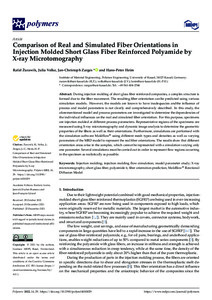| dc.date.accessioned | 2022-05-03T07:09:23Z | |
| dc.date.available | 2022-05-03T07:09:23Z | |
| dc.date.issued | 2021-12-22 | |
| dc.identifier | doi:10.17170/kobra-202205036119 | |
| dc.identifier.uri | http://hdl.handle.net/123456789/13802 | |
| dc.description.sponsorship | Gefördert durch den Publikationsfonds der Universität Kassel | |
| dc.language.iso | eng | |
| dc.rights | Namensnennung 4.0 International | * |
| dc.rights.uri | http://creativecommons.org/licenses/by/4.0/ | * |
| dc.subject | Injection molding | eng |
| dc.subject | injection molding flow simulation | eng |
| dc.subject | model parameter study | eng |
| dc.subject | X-ray microtomography | eng |
| dc.subject | short glass fiber | eng |
| dc.subject | polyamide 6 | eng |
| dc.subject | fiber orientation prediction | eng |
| dc.subject | Moldflow® Rotational Diffusion Model | eng |
| dc.subject.ddc | 600 | |
| dc.title | Comparison of Real and Simulated Fiber Orientations in Injection Molded Short Glass Fiber Reinforced Polyamide by X-ray Microtomography | eng |
| dc.type | Aufsatz | |
| dcterms.abstract | During injection molding of short glass fiber reinforced composites, a complex structure is formed due to the fiber movement. The resulting fiber orientation can be predicted using various simulation models. However, the models are known to have inadequacies andthe influence of process and model parameters is not clearly and comprehensively described. In this study, the aforementioned model and process parameters are investigated to determine the dependencies of the individual influences on the real and simulated fiber orientation. For this purpose, specimens are injection molded at different process parameters. Representative regions of the specimens are measured using X-ray microtomography and dynamic image analysis to determine the geometric properties of the fibers as well as their orientations. Furthermore, simulations are performed with the simulation software Moldflow® using different mesh types and densities as well as varying parameters of the MRD model to represent the real fiber orientations. The results show that different orientation areas arise in the samples, which cannot be represented with a simulation varying only one parameter. Several simulations must be carried out in order to represent flow regions occurring in the specimen as realistically as possible. | eng |
| dcterms.accessRights | open access | |
| dcterms.creator | Zurawik, Rafal | |
| dcterms.creator | Volke, Julia | |
| dcterms.creator | Zarges, Jan-Christoph | |
| dcterms.creator | Heim, Hans-Peter | |
| dc.relation.doi | doi:10.3390/polym14010029 | |
| dc.subject.swd | Kunststoffverarbeitung | ger |
| dc.subject.swd | Spritzgießen | ger |
| dc.subject.swd | Glasfaser | ger |
| dc.type.version | publishedVersion | |
| dcterms.source.identifier | eissn:2073-4360 | |
| dcterms.source.issue | Issue 1 | |
| dcterms.source.journal | Polymers | eng |
| dcterms.source.volume | Volume 14 | |
| kup.iskup | false | |
| dcterms.source.articlenumber | 29 | |


